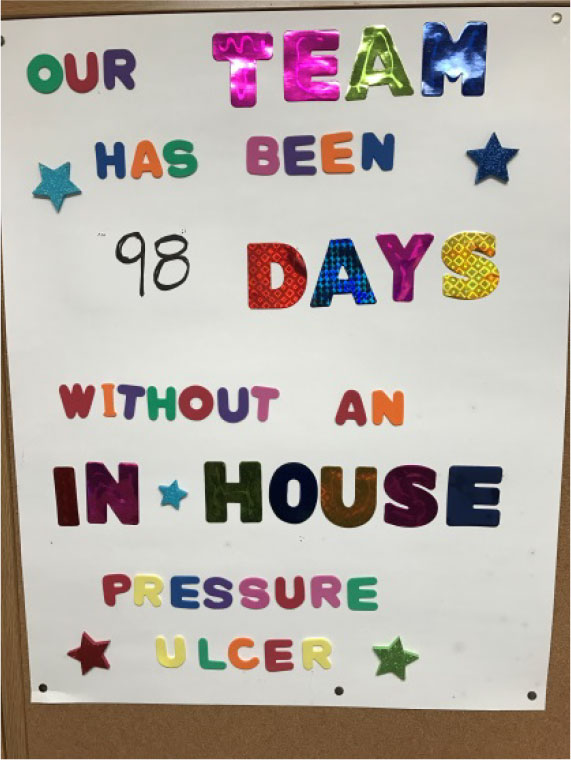 When the Madisonville Care Center, a nursing home in Madisonville, Texas, discovered several of its patients with new, facility-acquired pressure ulcers, it immediately began a comprehensive investigation engaging the best resources and tools to identify the source of the problem. The result was establishing stronger preventive care practices and a long run of no facility-acquired pressure ulcers.
When the Madisonville Care Center, a nursing home in Madisonville, Texas, discovered several of its patients with new, facility-acquired pressure ulcers, it immediately began a comprehensive investigation engaging the best resources and tools to identify the source of the problem. The result was establishing stronger preventive care practices and a long run of no facility-acquired pressure ulcers.
The TMF Quality Innovation Network Quality Improvement Organization (QIN-QIO) worked with the nursing home’s staff to teach them the process for conducting a root cause analysis and how to use the facility’s Quality MeasureComposite Score to identify areas for improvement. The TMF QIN advised the facility in using its weekly and daily skin assessments to complete its root cause analysis of each new pressure ulcer. The TMF QIN also directed a broad cross-section of the facility’s staff to the TMF QIN website where they viewed videos from the Quality Measures Video Series as well as a video on how to use the Facility-Acquired Pressure Ulcer Investigation Tool.
“Quality measures and composite scores are not just corporate numbers; they can be carried down to individual residents and define problems, not just record them,” said Justin Batson, the facility’s administrator.
The TMF QIN also pointed out that when a facility completes the Facility-Acquired Pressure Ulcer Investigation Tool it should be able to identify the true root cause(es) of the pressure ulcers and then implement quality improvement strategies to address these causes and get to a level of sustainability.
In addition, the facility’s staff participated in the TMF QIN’s monthly affinity group calls and webinars that provided opportunities to learn what other facilities are doing to help prevent pressure ulcers as well as other preventive measures. Facility staff participated in discussions about measure specifications for both the short-and long-stay quality measures for pressure ulcers. They learned that a facility-acquired pressure ulcer should be addressed and investigated immediately as an adverse event. The nursing home continues to participate in TMF QIN webinars and monthly calls.
By using these various resources, the facility developed stronger internal processes for its staff to follow that allowed them to better assess residents who, based on their conditions, might be high-risk candidates for developing pressure ulcers. It also guided them in establishing interventions to help prevent the development of pressure ulcers.
“Sixty to 70 percent of our resident population is wheelchair- or bed-bound, placing them at risk for pressure ulcers,” Batson said. “Ultimately, by instituting these interventions, our program had a positive effect on 100 percent of our population, ensuring every resident is checked to prevent the development of pressure ulcers.”
Batson added that the facility also hired a certified wound care nurse to take some of the workload off of the charge nurses. By having this specialized nurse on staff, the facility was able to put routine care of skin tears, rashes and abrasions back into the hands of its charge nurses. This made time for its wound care nurse to focus on pressure ulcer care, educating staff about prevention techniques to conduct at the bedside to help prevent pressure ulcers, and conducting weekly skin assessments.“
Our assistant director of nursing accompanies the wound care nurse to monitor treatments and care at the bedside of at least one resident on a daily basis,” Batson said. “On Fridays, when we do our corporate skin report, the staff meet to discuss each wound and each resident with potential for his or her skin issues.”
The facility also conducts group in-service sessions with its nurses and nurse aides on pressure ulcer prevention, nutrition, hydration and communicating changes in resident care based on changes in condition.The facility’s staff meets with its physicians to discuss additional resident needs.“
To help celebrate our staff’s success and keep momentum going, we hung a poster in the break room to count the days we are free of facility-acquired pressure ulcers,” Batson said. The facility had a run of 98 days pressure ulcer free.
This material was developed by TMF Health Quality Institute, the Medicare Quality Innovation Network Quality Improvement Organization, under contract with the Centers for Medicare & Medicaid Services (CMS), an agency of the U.S. Department of Health and Human Services. This content does not necessarily reflect CMS policy. 11SOW-QINQIO-C2-16-92 Revised 4/2017